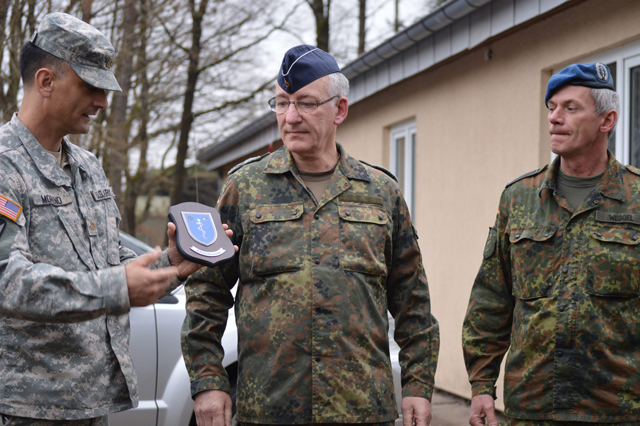
Maj. Gustavo Moreno, commander of the 160th Forward Surgical Team, 212th Combat Support Hospital, 30th Medical Brigade, 21st Theater Sustainment Command, receives a plaque bestowed by Maj. Gen. Stephan Schoeps, the surgeon general of the German air force, March 12, at Miesau Ammo Depot.
The 160th Forward Surgical Team of the 212th Combat Support Hospital, 30th Medical Brigade, 21st Theater Sustainment Command, conducted an interoperability exercise with 10 service members from the Bundeswehr Operational Medical Support Command March 9 to 12 at Miesau Ammo Depot.
It was an opportunity for German and American medics to learn about each other’s medical skills and equipment, and it opened the door for continued partnership.
“This exercise was a good way to showcase our capabilities and for them to integrate into how we operate and vice versa,” said Sgt. Daniel Dela Cruz, a medic who runs 160th FST’s advanced trauma life support section.
While the German military maintains an entity similar to the American combat support hospital, it doesn’t have a precise equivalent to the FST. The exercise was aimed at helping the German team construct a similar forward surgical capability.
“It is wonderful to learn (about) the FST and see how tactical and combat medicine works,” said German navy Cmdr. Elias Al-Ghabra, who played an important role in the exercise.
The Bundeswehr Operational Medical Support Command came to the exercise with an anesthesiologist, two anesthesiology assistants, three operating room technicians, two surgeons, a logistics officer and a medical planning sergeant major. The German team was a mix of air force, navy and army personnel, who came from various parts of the country, including Hamburg, Koblenz, Ulm, Berlin and Weissenfels.
The American unit provided a thorough brief on the organizational structure and mission of an FST. Led by Maj. Gustavo Moreno, a commander with extensive experience and expertise as an emergency room nurse, the 160th FST proved they were ideally suited to the combined training mission. Each member of the FST familiarized their German counterpart with their role in the unit. The teams triaged, stabilized, surgically intervened and post-operatively recovered simulated patients.
The teams also learned about one another’s equipment through hands-on demonstrations and training. To this end, the American and German teams set up fully functional trauma bays side by side.
The medics from the two countries also exchanged best clinical practices and identified redundancies and other operational challenges. They exercised patient care and flow scenarios.
The allies learned through the differences in their technique as well as the similarities. One difference lies in the German medical team’s customary reliance on buildings and modular containers — the FST is capable of setting up anywhere using its own tents and gear. While medical care procedures are essentially the same, the German team was eager to train and replicate the expeditionary capability as well as the ability to operate in an austere environment.
Al-Ghabra said he was so impressed with the exercise that he extended an invitation to the 160th FST’s personnel to visit his unit and integrate with them.
“Training like this should definitely continue so we can work anywhere, anytime under one system,” he said.







